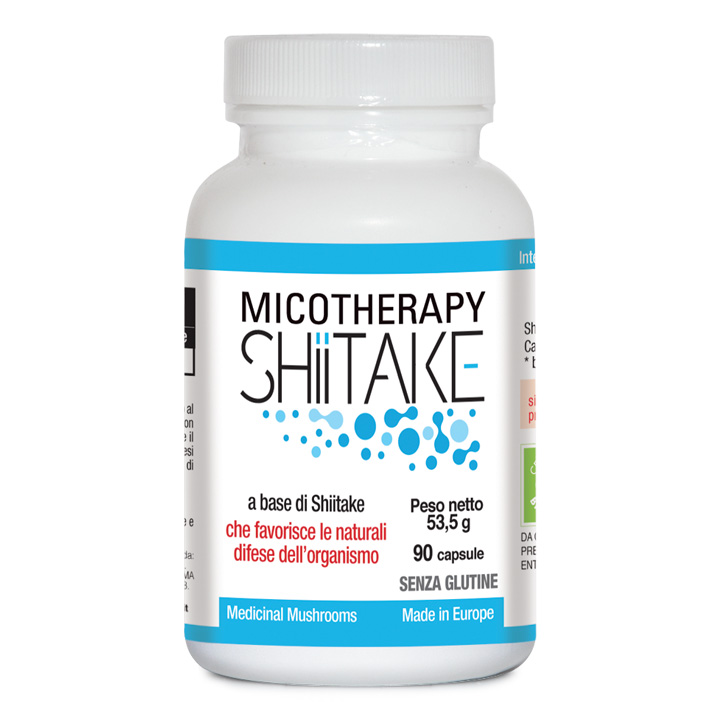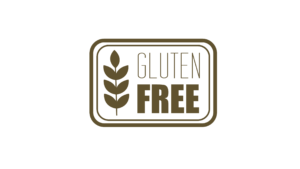
Modulatore del sistema immunitario
Integratore alimentare a base di Shiitake (Lentinula edodes) da coltivazione biologica (IT BIO 006) – Made in Europe.

Proprietà:
Chiamato anche “Re dei funghi”, lo Shiitake è stato tradizionalmente utilizzato in oriente per potenziare la risposta immunitaria, per promuovere la longevità e per il mantenimento della salute e del benessere psicofisico.
Lo Shiitake è ricco in molecole bioattive, micro e macronutrienti, minerali, aminoacidi, vitamine, enzimi, fibre e metaboliti secondari. Tra gli aminoacidi ci sono buone quantità di acido glutammico, chiamato anche “brain food”, un nutrimento per il cervello, che favorisce la produzione di neurotrasmettitori e il trasporto del potassio a livello cerebrale. Contiene elevati livelli di polisaccaridi (betaglucani) tra cui il Lentinan, un betaglucano ramificato (β 1-3 β 1-6) che ha evidenziato importanti proprietà di immunomodulazione. Una sostanza particolarmente efficace contenuta nello Shiitake è l’eritadenina, considerata il componente bioattivo più importante responsabile dell’abbassamento dei livelli di colesterolo.
Ingredienti:
- Shiitake (Lentinula edodes) sporophorum, da agricoltura biologica (IT BIO 006)
- Capsula in cellulosa vegetale
Modalità d’uso:
3 capsule al giorno preferibilmente lontano dai pasti
Formato:
confezione da 90 capsule
Note:

NO OGM
Ingredienti da agricoltura biologica – Made in Europe
Inserito nel registro degli integratori: codice 69251
Codice Paraf: 925363905
| TENORE MEDIO DEGLI INGREDIENTI CARATTERIZZANTI | PER DOSE GIORNALIERA (3 CPS) |
| Shiitake sporophorum | 1500 mg |
Bibliografia:
- Wasser SP, et al. Medicinal properties of substances occurring in higher Basidiomycetes mushrooms: current per- spectives. Int J Med Mushrooms 1999;1:31-62
- Chibata I, et al. Lentinacin: a new hypocholesterolemic substance in Lentinus edodes. Experientia 1969;25:1237-8
- Sugiyama K, et al. Eritadenine-induced alteration of hepatic phospholipid metabolism in relation to its hypocholesterolemic action in rats. J Nutr Biochem 1995; 6:80-7
- Steinberg D, et al. Beyond cholesterol: modifications of low-density lipoprotein that increase its atherogenicity. N Engl J Med 1989; 320:915-24
- Kabir Y, Kimura S. Dietary mushrooms reduce blood pressure in spontaneously hypertensive rats (SHR). J Nutr Sci Vitaminol (Tokyo) 1989;35:91-4
- Flynn, V.T. 1991. Is the shiitake mushroom an aphrodisiac and a cause of longevity. From: Science and Cultivation of Edible Fungi (Maher, ed.). Rotterdam: Balkema
- Fruehauf JP, 1982. The effect of lentinan on production of interleukin-1 by human monocytes. Immunopharmacology 5(1), 65-7
- Aiko WATANABE et al. Protection against D-Galactosamine-Induced Acute Liver Injury by Oral Administration of Extracts from Lentinus edodes Mycelia. Biol. Pharm. Bull. 29(8) 1651—1654 (2006)
- Ki Nam Yoon, et al. Antihyperlipidemic Effect of Dietary Lentinus edodes on Plasma, Feces and Hepatic Tissues in Hypercholesterolemic Rats. Mycobiology 39(2) : 96-102 (2011)
- Shoji Odani et al. The inhibitory properties and primary structure of a novel serine proteinase inhibitor from the fruiting body of the basidiomycete, Lentinus edodes. Eur. J. Biochem. 262, 915±923 (1999) q FEBS 1999
- M. Fukushima. Cholesterol-Lowering Effects of Maitake (Grifola frondosa) Fiber, Shiitake (Lentinus edodes) Fiber, and Enokitake (Flammulina velutipes) Fiber in Rats. Exp Biol Med Vol. 226(8):758–765, 2001
- Sullivan R, Smith JE, Rowan NJ. Medicinal Mushrooms and Cancer Therapy: translating a traditional practice into Western medicine. Perspectives in Biology and Medicine. 2006; 49(2): 159-170
- Yeung KS, Gubili J. Shiitake Mushroom ( Lentinula edodes ). J Soc Integr Oncol . 2008;6(3):134-135
- Miyaji CK, Poersch A, Ribeiro LR, Eira AF, Cólus IM. Shiitake ( Lentinula edodes (Berkeley) Pegler) extracts as a modulator of micronuclei induced in HEp-2 cells. Toxicol In Vitro . 2006;20(8):1555-1559
- Israilides C, Kletsas D, Arapoglou D, et al. In vitro cytostatic and immunomodulatory properties of the medicinal mushroom Lentinula edodes . Phytomedicine . 2008;15(6-7):512-519
- Yang P, Liang M, Zhang Y, Shen B. Clinical application of a combination therapy of lentinan, multi-electrode RFA and TACE in HCC. Adv Ther . 2008;25(8):787-794
- Maekawa S, Saku M, Kinugasa T, et al. 1990;17:137-140
- Suzuki M, Higuchi S, Taki Y, Taki S, Miwa K, Hamuro J. Induction of endogenous lymphokine-activated killer activity by combined administration of lentinan and interleukin 2. Int J Immunopharmacol . 1990;12(6):613-623
- gawa K, Watanabe T, Katsube T, et al. Study on intratumor admionistration of lentinan – primary changes in cancerous tissues [in Japanese]. Gan To Kagaku Ryoho . 1994;21(13):2101-2104
- 9Yin Y, Fu W, Fu M, He G, Traore L. The immune effects of edible fungus polysaccharides compounds in mice. Asia Pac J Clin Nutr . 2007;16(suppl 1):258-260
- Yu S, Weaver V, Martin K, Cantorna MT. The effects of whole mushrooms during inflammation. BMC Immunol . 2009;10:12
- Lee JY, Kim JY, Lee YG, Rhee MH, Hong EK, Cho JY. Molecular mechanism of macrophage activation by Exopolysaccharides from liquid culture of Lentinus edodes . J Microbiol Biotechnol . 2008;18(2):355-364
- Péter G, Károly V, Imre B, János F, Kaneko Y. Effects of lentian on cytotoxic functions of human lymphocytes. Immunopharmacol Immunotoxical . 1988;10(2):157-163
- Takeshita K, Saito N, Sato Y, et al. Diversity of complement activation of lentinan, an antitumor polysaccharide, in gastric cancer patients [in Japanese]. Nippon Geka Gakkai Zasshi . 1991;92(1):5-11
- Tani M, Tanimura H, Yamaue H, et al. Augmentation of lymphokine-activated killer cell activity by lentinan. Anticancer Res . 1993;13(5C):1773-1776
- Tani M, Tanimura H Yamaue H, et al. In vitro generation of activated natural killer cell sand cytotoxic macrophages with lentinan. Eur J Clin Pharmacol . 1992;42(6):623-627
- Arinaga S, Karimine N, Takamuku K, et al. Enhanced induction of lymphokine-activated killer activity after lentinan administration in patients with gastric carcinoma. Int J Immunopharm . 1992;14(4):535-539
- Arinaga S, Karimine N, Nanbara S, et al. Enhanced production of interleukin 1 and tumor necrosis factor by peripheral monocytes after lentinan administration in patients with gastric carcinoma. Int J Immunopharm . 1992;14(1):43-47
- Zhou LD, Zhang QH, Zhang Y, Liu J, Cao YM. The shiitake mushroom-derived immuno-stimulant lentinan protects against murine malaria blood-stage infection by evoking adaptive immune-responses. Int Immunopharmacol . 2009;9(4):455-462
- Kaneko Y, Chihara G. Potentiation of host resistance against microbial infections by lentinan and its related polysaccharides. Adv Exp Med Biol . 1992;319:201-215
- Guo Z, Hu Y, Wang D, et al. Sulfated modification can enhance the adjuvanticity of lentinan and improve the immune effect of ND vaccine. Vaccine . 2009;27(5):660-665
- Hearst R, Nelson D, McCollum G, et al. An examination of antibacterial and antifungal properties of constituents of Shiitake ( Lentinula edodes ) and oyster ( Pleurotus ostreatus ) mushrooms. Complement Ther Clin Pract . 2009;15(1):5-7
- Tochikura T, Nakashima H, Kaneko Y, Kobayashi N, Yamamoto N. Suppression of human immunodeficiency virus replication by 3′-azido-3′-deoxythymidine in various human hematopoietic cell lines in vitro: augmentation of the effect by lentinan. Jpn J Cancer Res . 1987;78(6):583-589
- Yoshida O, Nakashima H, Yoshida T, et al. Sulfation of the immunodulating polysacchraride lentinan: a novel strategy for antivirals to human immunodeficiency virus (HIV). Biochem Pharmacol . 1988;37(15);2887-2891
- Gordon M, Bihari B, Goolsby E, et al. A placebo-controlled trial of the immune modulator, lentinan, in HIV-positive patients: a phase I/II trial. J Med . 1998;29:305-330
- Ngai PHK, Ng TB. Lentin, a novel and potent antifungal protein from shitake mushroom with inhibitory effects on activity of human immunodeficiency virus-1 reverse transcriptase and proliferation of leukemia cells. Life Sci . 2003;73(26):3363-3374
- Chibata I, Okumura K, Takeyama S, et al, Lentinacin: a new hypocholesterolemic substance in Lentinus edodes . Experientia . 1969;25:1237-1238
- Rivera A, Benavides OL, Rios-Motta J. (22E)-Ergosta-6,22-diene-3beta,5alpha,8alpha-triol: a new polyhydroxysterol isolated from Lentinus edodes (Shiitake). Nat Prod Res . 2009;23(3):293-300
- Chihara G. Recent progress in immunopharmacology and therapeutic effects of polysaccharides. Dev Biol Stand . 1992;77:191-197
- Aalto-Korte K, Susitaival P, Kaminska R, Mäkinen-Kiljunen S. Occupational protein contact dermatitis from shiitake mushroom and demonstration of shiitake-specific immunoglobulin E. Contact Dermatitis . 2005;53(4):211-213
- Suzuki K, Tanaka H, Sugawara H, et al. Chronic hypersensitivity pneumonitis induced by Shiitake mushroom spores associated with lung cancer. Intern Med . 2001;40(11):1132-1135
- Mak RK, Wakelin SH. Shiitake dermatitis: the first case reported from a European country. Br J Dermatol . 2006;154(4):800-801
- Levy AM, Kita H, Phillips SF, et al. Eosinophilia and gastrointestinal symptoms after ingestion of shiitake mushrooms. J of Allergy Clin Immunol . 1998;101(5):613-620
- Ciric L et al. In Vitro Assessment of Shiitake Mushroom (Lentinula edodes) Extract for Its Antigingivitis Activity. Journal of Biomedicine and BiotechnologyVolume 2011 (2011), Article ID 507908, 7 pages
- Signoretto C et al. Testing a Low Molecular Mass Fraction of a Mushroom (Lentinus edodes) Extract Formulated as an Oral Rinse in a Cohort of Volunteers. Journal of Biomedicine and BiotechnologyVolume 2011 (2011), Article ID 857987, 7 pages
- Zaura E et al. The Effects of Fractions from Shiitake Mushroom on Composition and Cariogenicity of Dental Plaque Microcosms in an In Vitro Caries Model. Journal of Biomedicine and BiotechnologyVolume 2011 (2011), Article ID 135034, 10 pages
- Lingstrom P et al. The Anticaries Effect of a Food Extract (Shiitake) in a Short-Term Clinical Study. Journal of Biomedicine and BiotechnologyVolume 2012 (2012), Article ID 217164, 10 pages
- Venturini M et al. Antimicrobial Activity of Extracts of Edible Wild and Cultivated Mushrooms against Foodborne Bacterial Strains. Journal of Food Protection®, Number 8, August 2008, pp. 1544-1741 , pp. 1701-1706(6)
- Bisen PS et al Lentinus edodes: A Macrofungus with Pharmacological Activities Current Medicinal Chemistry, 2010, 17, 2419-2430 2419
per ulteriori informazioni visitate il sito: www.micotherapy.it




